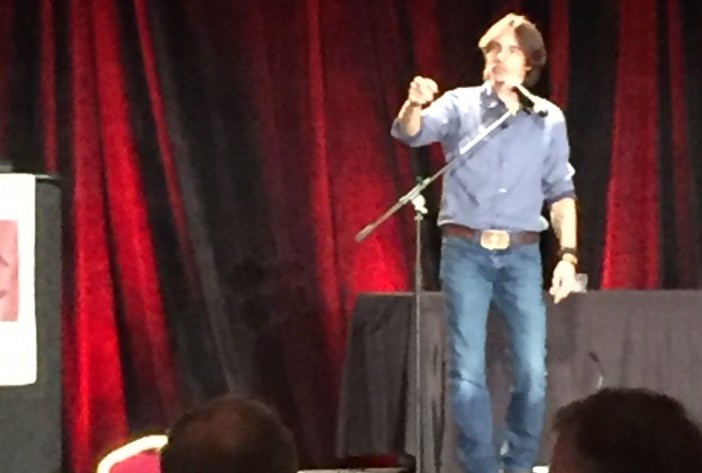
by Julie | Nov 1, 2016 | Interim Management, Management
Last week, the Investment Casting Institute hosted the 63rd Annual Technical Conference and Expo. The key note speaker was Keni Thomas, a former Army Ranger who was awarded the Bronze Star for Valor and the Combat Infantryman’s Badge from the United States Army. Keni was one of our brave soliders who fought in the “Black Hawk Down” battle in Mogadishu, Somalia.
If you have seen the movie “Black Hawk Down” then you know the story, but, his talk didn’t focus on what happened during that battle as much as the importance of leadership. He quoted the Army manual on Military Leadership’s definition of leadership: “Leadership is the process of influencing others to accomplish the mission by providing purpose, direction and motivation.”
As he points out, there is nothing in the definition that mentions rank, position or pay-grade. Leadership is about the example you set regardless of where you fall in the pecking order.
Often times when we are faced with a problem at work, we wait for some one else to fix it. Keni’s point was that we shouldn’t wonder who is going to fix it but rather, we should just accept responsibility and get it done.
Imagine how much more we could get done if everyone adopted this philosophy. What if we spent time explaining to each team member the importance of their individual role and how it impacts the greater good? What if our organizations developed leaders rather than supervisors and managers, how much further along would the organization be?
At the end of his speech, Keni received a standing ovation. There is no doubt that part of this was a heart felt appreciation for what the military does to keep us safe and the sacrifices they make along the way. But, I also believe that his humble perspective of the value that every team member contributes to the greater good was a powerful wake-up call to the entire audience.
Thank you Keni Thomas. Thank you US Military. Thank you to those people in our lives that demonstrate leadership on a daily basis.

by Julie | Oct 13, 2016 | Management, Process Improvement
GIVING YOUR EMPLOYEES THE TOOLS THEY NEED TO DRIVE IMPROVEMENT
After writing my article titled, “Don’t Rely on Super Heroes to Achieve Your Business Objectives”, I received numerous comments about not wanting to have too strict of a process that it stifles operator input. I completely agree as we need employees who are engaged in their work to drive improvements. And in order to do that, they need to have the freedom to come up with new, innovative ways to improve the processes they work in every day.
As a manager, I would tell my employees, if you make a wrong decision but your thought process is right, then we will do some coaching about how you arrived at your decision. But, if you make a wrong decision and your thought process is wrong, we will have a completely different discussion.
My team knew my priorities were: safety, quality and communication. So, as they made changes, they needed to think through how the changes would impact these priorities.
The area where they struggled the most was communication. Having honest, direct communication is difficult and in order to that well, employees need to see this demonstrated on a consistent basis and be given the necessary training on how to communicate effectively, especially in emotional situations.
As they made process improvements, we would talk through their decision making process and as necessary, make suggestions on how things could be improved upon in the future. Of course, there were times when decision making wasn’t done with safety, quality or communication in mind. During those difficult circumstances, I would discuss how the outcome could have been improved by keeping them in mind.
Over time, my team was better equipped to make improvements to the process while keeping the business priorities at the forefront of their minds. This provided an opportunity to make process improvements without relying on their favorite super hero.

by Julie | Sep 29, 2016 | Efficiency, Management, Process Improvement
Addressing the Gaps in Your Systems
Your plant has highly detailed procedures on how to do each job. The operators are trained not to deviate from the procedures. But, what happens when a conscientious operator notices as problem with a part. In order to properly process it, the operator must deviate from the procedure. Without a system which instructs the operator how to handle this situation, scrap parts may be made.
So, what does the operator do? Deviate from the procedure or blindly follow the process?
W. Edwards Deming, considered the patriarch of process control was quoted as saying, “A bad system will beat a good person every time.” John Hunter, author of Management Matters summed this is up best by saying, “relying on heroic measures is a bad way to manage.”
If you want your people to be successful, you need to put the systems in place in order to allow them to do that. If you find your employees are making a lot of mistakes, perhaps the training system needs to be augmented in order to prevent mistakes from happening. If you find your employees aren’t consistently performing at the level that is required, maybe it is time to review the processes they use on a daily basis and address those areas that are causing issues.
I love super heroes, but, I wouldn’t want to have to depend on them every day to make my business successful!

by Julie | Sep 22, 2016 | Interim Management, Management
The Best Way to Improve Your Bottom Line
I recently met with a managing partner of a professional services firm. His philosophy on how to approach his clients was simply stated, “when the ball falls on the line, the client gets the point.” He believes the customer will remember how they were valued when there is a “tie” and that will impact their long-term relationship.
What a refreshing way to approach our customers. I believe more and more businesses are forgetting the importance of taking care of the customer. As competition increases, it becomes increasingly difficult to stand out from the crowd.
Providing exceptional service is a great way to separate your business from your competitors. Have you walked into a business and felt like you have known the employees forever? Conversely, have you walked into a business and sensed no one cared if you buy from them or not?
That “vibe” comes from the internal culture. If your employees feel valued, they will value their work. If your employees have the customer at the forefront of their daily tasks, they will make decisions that are in the best interest of the customer. But if your employees don’t feel valued, that will be reflected in their work.
A recent study completed by Gallup found that having an engaged workforce can impact profitability, productivity, turnover, employee safety, absenteeism and quality.
Want to guess what Gallup found to be the top influencer for employee engagement? The direct manager.
So, if you want to grow your business, increase profitability or improve your safety record, then now is the time to focus on improving the quality of your management team.

by Julie | Sep 1, 2016 | Employee Training, Management, Safety
It is back to school time. I remember when I was younger, I was thinking about what to wear for the first day of school, making sure I had the perfect outfit for the school yearbook. But, as I got older, my focus turned to the subjects that I was going to be studying. Some my questions were: How hard is the professor? How much homework will she give us? How many exams will we have to take? As I reflect back, I don’t remember thinking much beyond passing each course. In fact, in Linear Analysis, a 400-level math course, the professor actually said and I quote, “I know I have a lot of engineering students in this class and you are wondering what the practical application is for this subject and I will tell you – I have no idea.” And he was right – I have never used anything I learned in that class in the real world.
But, as we look at training our operators, it is important that the information that is being presented has a practical application that the operators can apply to their work and/or personal lives. This doesn’t just apply to the training around their daily tasks, but, it also applies to safety training, HR training and environmental training.
When presenting training to operators, try to tie in real world experiences to the material. In the past, when conducting ladder safety training – I talked about how I almost fell off a ladder while cleaning my gutters at my house. Or when discussing PPE, I talk about the importance of wearing safety glasses, even when working on projects at your home. When discussing environmental training, I include tips on how to dispose of hazardous household chemicals.
If the training material is something that the operator can personalize and understand why it is important, at work or in his personal life, the training will have a much greater impact.
And if you do that, I am sure your operators will be more engaged and receptive than I was in Linear Analysis.
For more practical tips for manufacturing professionals to attract, train and retain your hourly workforce, go to www.keyprocessinnovations.com.





